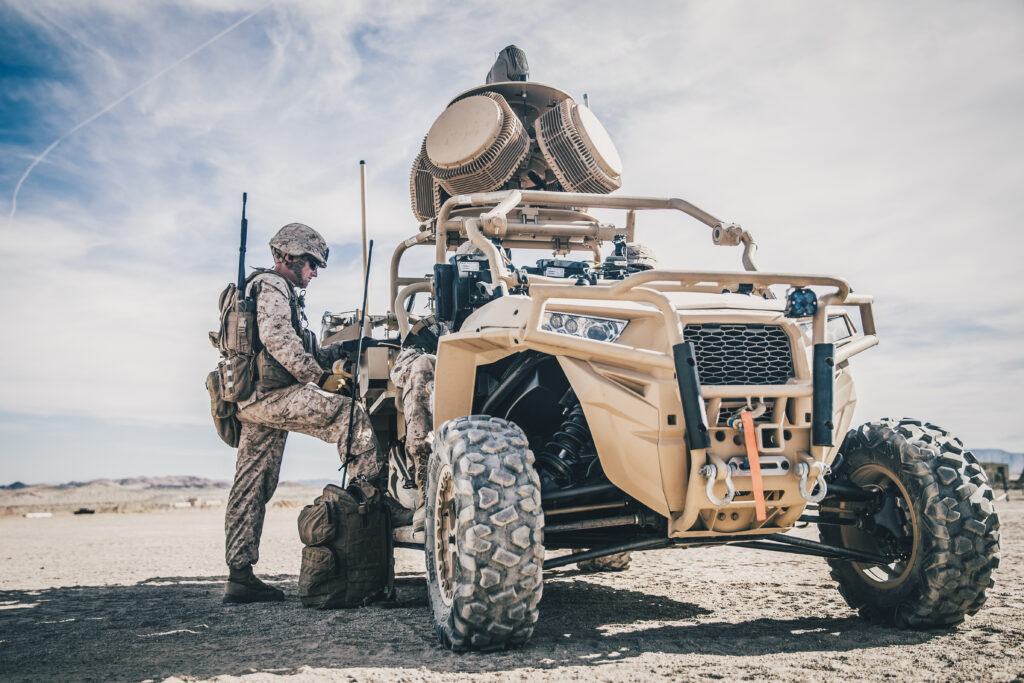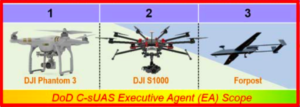
A Marine with the L-MADIS counter-drone system, sensors and jammers mounted on a Polaris M-RZR 4×4.
WASHINGTON: DoD’s first joint strategy to counter small drones is about to hit Defense Secretary Mark Esper’s desk, says Army Maj. Gen. Sean Gainey, head of the Joint Counter-small Unmanned Aerial Systems Office (JCO).
The new strategy and a joint requirements document to guide service investment was signed on Sept. 28 by Vice Chairman of the Joint Chiefs of Staff John Hyten, Army officials said today at the annual Association of the US Army show. The strategy is expected to be released early next month.
The JCO, in tandem with the Army Rapid Capabilities and Critical Technologies Office (RCCTO), will hold an “industry open house” on the requirements Oct. 30, Gainey said. The RCCTO serves as the materiel and acquisition lead in support of the JCO.
“The open house that we’re going to have with industry the 30th of October is really our first engagement forum where we’re bringing everybody together,” Gainey elaborated. “We’re at the point now where we can talk to industry about our requirements and lay out to industry: these are the requirements that weren’t part of the original set of equipment that we want your help with, and that we want you to bring to our test ranges and show us what you’re doing to get after this capability focus area.”
The plan is to hold a second industry day about six months later to hone in on more specific requirements, and to open up test ranges for demonstrations at around the same time.
The new counter-drone strategy will be implemented during the 2023 and 2027 budget cycle, said Nicole Thompson, JCO division chief for strategy and policy. “We’re doing things now and we do things next year, but we’re really focusing on kind of laying some of some of those things down across the POM and resourcing them,” she said.
The operational requirements document will lay out more specifically the capabilities needed by the joint forces and be updated over time to reflect evolving technology, said Marc Pelini, JCO division chief for
capabilities and requirements.
The plan, he explained, it to “refresh” the requirements every 18 to 24 months as new technologies mature. The JCO wants to be able to predict “where technology is going to go and providing industry with guidance on additional capabilities that need to come online,” he said, across any piece of the counter-drone mission, from initial detection to shoot down.
The requirements document will guide service acquisitions, Pelini said. “Our intent for the operational requirements is really kind of providing strategic guidance to the Department of Defense on how capabilities will be developed,” he explained. Each service will still develop specific requirements for their individual platforms as part of their acquisition plans, but in line with the joint requirements and the overarching strategy, he added.
The JCO serves as the Pentagon’s Counter Small Unmanned Aerial System (C-sUAS) Executive Agent (EA). The EA is charged with finding joint solutions to the threat caused by small drones, and to ensure that the services don’t duplicate each other’s efforts. Esper approved the EA implementation plan on Jan. 6. The JCO’s mandate covers Category 1, 2 and 3 drones, which range from those weighing less than 20 pounds to those weighing up to 1,320 pounds.

The JCO’s mandate covers adversary drones in the Category 1, 2 and 3 range. Army image.
Gainey told AUSA last year that the JCO’s tasks for 2020 included: a DoD Directive; a Joint C-sUAS threat assessment; a DoD counter-drone strategy; down-select of Joint Urgent Operational Need (JUON) counter-drone systems; and a Joint Capability Development Document including delivering capabilities to the warfighter.
As Sydney reported in June, the office down-selected from some 40 efforts across the Army, Navy and Air Force to pick seven current counter-drone systems, each to be managed by an individual service. It also selected a single standard architecture for common-and-control, mandating the Army’s FAAD-C2,or a compatible C2 network such as the Air Force’s Multi-Environmental Domain Unmanned Systems Application (MEDUSA), to be used by all service programs.
“The department will continue to work with industry to bring these interim systems to full maturity, or to eventually replace them with follow-on enduring systems, and this is probably where our most of our effort is going right now,” Gainey said.
Gainey said one of the challenges in protecting both military installations in the United States and abroad is working with domestic authorities to ensure that any counter-drone activities — including efforts to detect airborne threats — don’t disrupt civilian air traffic and/or communications. (Counter-drone systems often rely disrupt electro-magnetic signals or the use of directed-energy weapons, such as lasers or high-powered microwaves, that could have area-wide effects.)
“We have those hazard challenges, not only in CONUS, but also in our installations globally, where we work closely with the host nations, whether it’s in EUCOM or INDOPACOM, where we have to adhere to the host country’s authorities, and be able to balance the operational capabilities we have while working with their authorities in their local law enforcement to be able to get after this correctly,” he said.






















